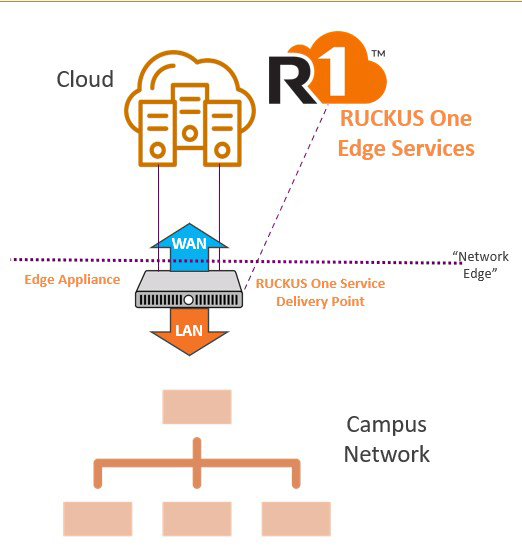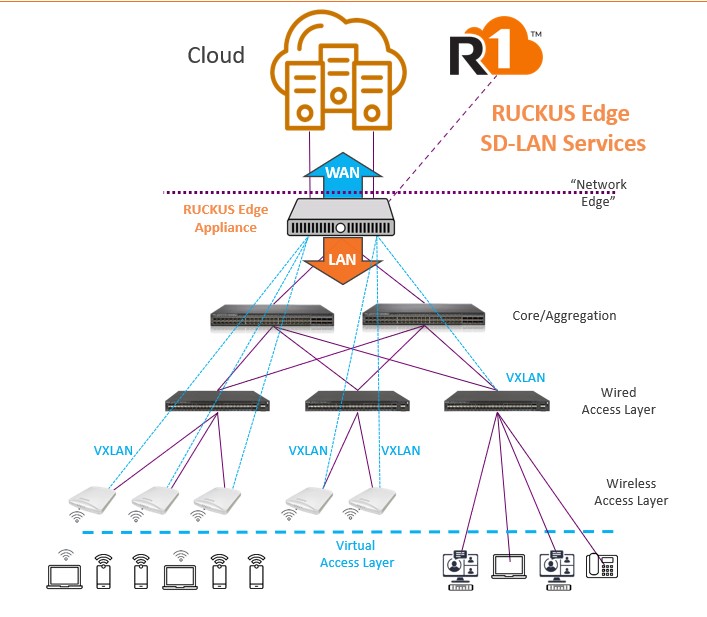Overview:
RUCKUS Edge is a Service Delivery Platform that extends RUCKUS One to the
edge and it is built on the RUCKUS One cloud platform. It leverages the RUCKUS
One Service Catalog to offer an easy to deploy, scalable and flexible approach to
services delivery at the edge of the network. By leveraging cloud orchestration
and an edge appliance as the local service delivery point, the solution provides
centralized cloud based control while maintaining performance and flexibility at
the network edge.

Figure: RUCKUS Edge service delivery architecture
MASSIVE ADOPTION OF CLOUD BASED APPLICATIONS BRINGS NEW CHALLENGES
The rapid adoption of cloud computing and cloud-based applications is
transforming many industries and delivers many benefits like deployment
simplicity, flexibility and user mobility. However, this shift also brings new
challenges in areas like application latency, security, and data privacy to name
a few, which are critical to the success of these sectors. In hospitality, guests
expect real-time, seamless experiences, from booking systems to in-room
services powered by IoT devices. In MDUs, residents increasingly demand
reliable, low-latency access to smart home applications and entertainment
services. Similarly, educational institutions must ensure uninterrupted access
to cloud-based learning tools and collaborative platforms. The traditional,
centralized cloud model struggles to meet these high-performance demands,
often leading to lag, reduced service quality, and security risks.
THE NETWORK EDGE: A STRATEGIC SERVICE DELIVERY POINT
The network edge has emerged as a strategic service delivery point for
addressing these new challenges. By processing data closer to its source, edge
computing can significantly reduce latency, ensuring a faster, more responsive
user experience. For instance, in hospitality, edge solutions can enhance guest
services by enabling real-time personalization and improving operational
efficiency. In MDUs, edge services enable residents to enjoy uninterrupted
connectivity for their smart devices, gaming systems, and streaming platforms.
Educational institutions can also benefit from the enhanced performance and
security that edge computing provides, ensuring secure access to learning
materials without compromising student data privacy.
EDGE SERVICES: A SOLUTION TO ADDRESS CLOUD COMPUTING CHALLENGES
Edge services not only reduce latency but also strengthen
security and privacy by keeping sensitive data within local
environments, rather than sending it across vast networks to
distant cloud data centers. This combination of faster service
delivery and enhanced security is crucial for these industries,
making the edge an essential component in their digital
transformation efforts.
HYBRID CLOUD ARCHITECTURE: EDGE DELIVERY / CLOUD ORCHESTRATION
RUCKUS Edge is built on the RUCKUS One cloud platform and uses its Service Catalog to offer an easy to deploy, scalable and flexible approach to services delivery. By leveraging cloud orchestration and an edge appliance as the local service delivery point, the solution provides centralized control while maintaining performance and flexibility at the network edge. RUCKUS One offers organizations the benefits of a single Cloud based platform to manage wired, wireless and IoT networks together, streamlining operations and reducing the need for on-premises infrastructure. The cloud-based management platform simplifies network configuration, monitoring, and updates, while the edge appliance handles local breakout for performance optimization. This hybrid approach offers a cost-effective, scalable solution that meets the needs of dynamic, distributed environments such as MDUs, campuses, and enterprises. The architecture ensures secure, highperformance network operations while lowering operational costs through automation and centralized management
Features and Benefits:
Hybrid cloud management via RUCKUS One
RUCKUS Edge is centrally managed via RUCKUS One, a hybrid cloud platform that provides cloud-based orchestration. This allows network administrators in distributed environments to manage, configure and monitor their edge services across multiple locations through a single platform.
High availability with edge appliance clusters
Edge appliances can be deployed in redundant clusters for high availability and failover—boosting network reliability and resilience and ensuring continuous service in mission-critical environments where network downtime is not an option.
Standards-based VXLAN tunneling for network segmentation
VXLAN tunnels create virtual layer 2 networks over a standard layer 3 infrastructure, enabling large-scale network segmentation. This feature frees applications and users from the constraints of the physical network infrastructure and campus topology, ensuring that multiple groups or applications can get their own isolated virtual network segment across the campus—improving security, data privacy and mobility.
Seamless, zero-touch, Wi-Fi roaming across the campus
Deliver seamless Wi-Fi roaming across the campus by enabling devices to keep their IP address while roaming from one AP to the next. Seamless roaming allows connections to critical services like video and voice to remain uninterrupted as users move across the campus. This feature also frees the network administrator from tedious manual configuration of physical network devices.
Benefits:
- Simplified Deployment and Management
Centralized Cloud Management and Edge Appliance as a Service Delivery Point: The cloud-managed platform automates many tasks through a web interface and a mobile app lowering operational complexity.
- Scalability and Flexibility
RUCKUS Edge can scale to address the needs of
organizations of any size. Multiple edge appliances
can be clustered lo load balance and distribute
workloads across multiple devices.
- Improved Security and Privacy
Segmented Network Security: VXLANs allow for
isolated virtual network segments, ensuring that
different user groups have secure, isolated access
to network resources.
- Reduced Latency & Faster Data Transmission
By using the edge appliance for local breakout,
performance is improved as traffic is processed
closer to the user.
- Pay-as-You-Go Model
Cloud services offer flexible, subscription-based
pricing, allowing organizations to pay only for what
they use, reducing the total cost of ownership
(TCO).
- High Availability and Reliability
Redundant, Clustered Edge Appliances can be
deployed for critical sites to ensure network
resilience and prevent downtime.
- AI-Driven Assurance and Insights
RUCKUS One leverages AI to deliver network
assurance, enabling IT administrators to detect
and resolve incidents before they become service
affecting and impacting users.
- Converged Management Across IT and OT
The hybrid cloud platform allows for the
management of both wired and wireless LAN
environments as well as IoT networks, offering
seamless network integration and reducing
operational silos.
- Open APIs for Integration
RUCKUS One offers open APIs for integration with
third-party systems and services, enabling better
customization and adaptability to organizational
needs.
RUCKUS Edge SD-LAN Service
RUCKUS Edge SD-LAN is a cloud-managed service designed to
bring advanced network virtualization and automation to the
edge, leveraging the powerful RUCKUS One service catalog.
Deployed directly from the cloud onto edge appliances, this
service enables organizations to create highly tailored virtual
overlay networks with just a few clicks. Whether it’s to meet the
specific needs of applications, user groups, use cases, or device
types, RUCKUS Edge SD-LAN makes it simple to define and
manage custom network environments without the complexity of
traditional networking setups.
The service allows seamless creation of SD-LAN virtual networks,
providing fine-grained control over network traffic, segmentation,
and security. With support for features such as private VLANs
(PVLANs) and device discovery, administrators can quickly spin
up isolated or dedicated networks for specific applications or
user groups, ensuring that each segment gets the resources
and access it needs. All of this is managed through the intuitive
RUCKUS One cloud interface, which streamlines network
deployment, management, and troubleshooting. The result is a
flexible, highly responsive network environment that adapts to
evolving organizational needs with ease and scalability.

Figure: RUCKUS SD-LAN Edge Service Architecture
Simple
RUCKUS Edge SD-LAN service is designed with simplicity at its
core, offering cloud-based management accessible through
both web interface and mobile app. The streamlined interface
allows for fast deployment from the cloud and easy configuration,
making it accessible even for non-expert users.
Reliable
Reliability is ensured through cluster failover, which provides
high availability for critical services. In case of a hardware or
network failure, the system automatically transfers operations
to a backup cluster, maintaining uninterrupted network service
and ensuring continuous operation without downtime.
Scalable
As your needs grow, RUCKUS Edge SD-LAN grows with you.
The system uses cluster load balancing to distribute workloads
evenly across edge appliance devices, ensuring optimal
performance at any scale. Whether managing a small network
or expanding to a large, multi-building campus environment, the
solution scales efficiently and effortlessly.
Open Standards Based
Built on open standards, RUCKUS Edge SD-LAN leverages
VXLAN over standard Ethernet and IP networks, offering
seamless integration with existing infrastructures. This ensures
compatibility with diverse hardware and software ecosystems,
allowing for flexible network extension and modernization
without vendor lock-in.
Flexible
RUCKUS Edge SD-LAN adapts to your specific needs, offering
SD-LAN overlays on demand. Overlay Networks can be tailored
per user, application, or use case, providing dynamic resource
allocation and customized services as needed. This flexibility
ensures that the network evolves in sync with your unique
business requirements.
Choose from flexible deployment options
Deploy RUCKUS Edge virtual or physical appliances to optimize and scale your traffic.
- Physical appliances (RUCKUS Edge 144 appliance) benefit organizations that have non-specialized IT departments with limited virtualization expertise or those that wish to further simplify deployments in tenant locations.
- Virtual form factor (RUCKUS Edge virtual appliance) is targeted at organizations with specialized IT teams that have expertise in deploying a virtualized infrastructure across central and tenant locations.
| KEY CAPABILITIES |
VIRTUAL EDGE |
EDGE APPLIANCE |
| Hypervisor support |
|
N/A |
| Dynamic data plane scaling |
Options:
- 1 Gbps
- 10 Gbps
- Higher throughput capacities with LAGs
|
Options:
- 1 Gbps
- 10 Gbps
- Higher throughput capacities with LAGs
|
| Redundancy |
- Up to 4 instances in Active/Active
- Up to 2 instances in Active/Standby
|
- Up to 4 instances in Active/Active
- Up to 2 instances in Active/Standby
|
| Services |
- DHCP server/NAT*
- SD-LAN
- Layer 3 roaming
- Personal Identify Network (PIN)*
- Guest Anchor
- WAN Gateway*
|
Note: * Available in a future software release
| SYSTEM REQUIREMENTS |
| Hypervisor support |
- VMware ESXi 6.0 and later
- KVM (Debian 64 bit)
|
| Processor |
|
| Number of cores |
|
| Memory |
- Minimum 8 GB memory per instance
|
| SSD |
|
| NICs that support Intel DPDK |
- Intel NICs iab, ixabe
- 82576, I350
- 82599EB, 82599, X520 (the above have been validated in Ruckus Labs)
|
Specifications:
| EDGE APPLIANCE PHYSICAL CHARACTERISTICS |
| Power |
- Dual hot-swappable redundant AC power supplies (one included, second one optional)
- AC power consumption: 135W
- Power Rating: 100-127VAC/200-240VAC, 47-63HZ
|
| Dimensions |
- 1RU rack mountable: 435 mm (W) x 522 mm (D) x 44 mm (H); 17.13 in (W) x 20.55 in (D) x 1.73 in (H)
|
| Weight |
|
| Connections |
- 4 - 1GbE ports
- 4 - 10GbE ports
|
| LED |
- Front panel LEDs, one rear LED
|
| Fans |
- Three (Field-Swappable fans FRU 902-S120-0000)
|
| Mean-Time-Between-Failure (MTBF) |
- At 25C: 167,007 hours
- With 2x fans and 1x AC power supply unit
|
| Environmental Conditions |
- Operating temperature: 0°C (32°F) – 40°C (104°F)
- Operating humidity: 5% to 95%, non-condensing
- Humidity storage: 95%, non-condensing
|
Documentation:
Download the RUCKUS Edge Datasheet (PDF).




